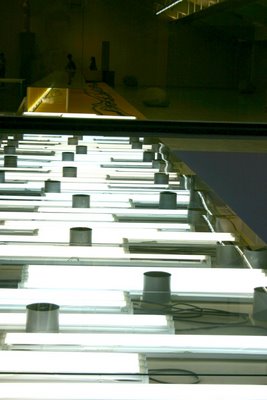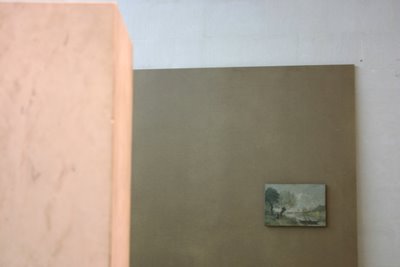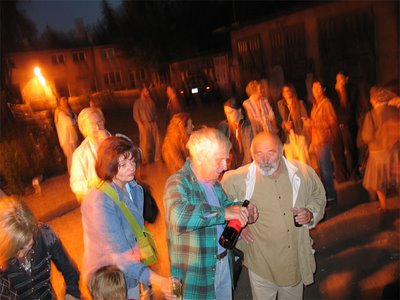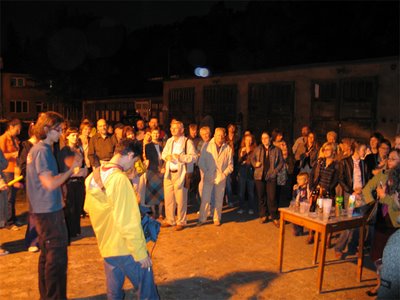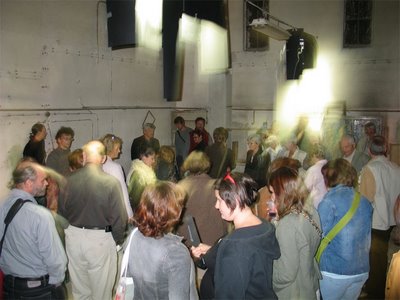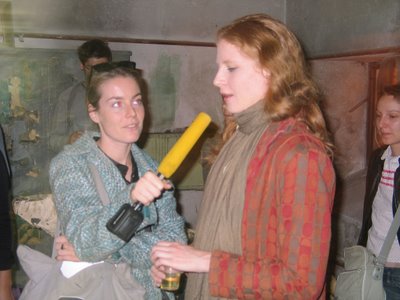1.
The exhibition "Sexuality and Transcendence" at the Pinchuk Art Center in Kiev, Ukraine (open until 19.09) fulfills its task better than it could hope for. If you expect an overwhelming, total experience, you got it all wrong. The space was not designed for anything overwhelming – the narrow staircase leads to narrow rooms, everything is fit-to-measure, and in consequence too small for the abstract pseudo-objectivity we are used to in most contemporary museum spaces. It could be a great space to move towards the intimate, and the topic seems to welcome such an interpretation.
This is not the case either. This version of transcendence seems to have little to do with what grows out of the self, or moves beyond it. It sometimes appears like it's all about impressing the hell out of us, poor mortals, and this state of awe at first reading seems to be the contemporary proposition of transcendence.
But there is more.
Yes, it is but a collection of the creme de la creme of contemporary art. Yes, it focuses more on showing off the stars and thus confirming the power of the producer. Its sexuality, beyond a few exceptions, lies more in the power fetish of the curator than in the actual exploration of the field. Sexuality is not sexual - here it is first and foremost an artistic product.
Transcendence, here, is a plastic material that shines and can be molded into big lumps of money. It is mainly about transcending sex – by overtaking it with colorful, shapely, huge art gadgets. So we get our yearly fix of Takashi Murakami, Jeff Koons, Richard Price, a touch of Cattelan and Sarah Lucas. All this is a clear power-play. Apparently, sexuality is in most cases a clear excuse for power plays.
 Is this the new transcendence? Having spent the day walking around Kiev, I get a slightly different impression. What if this was not an exhibition trying to interpret concepts in a universalist way? What if it was about how the people here see transcendence? The people who function in the art world? The rich? The ones with access to culture? Then it all makes sense: sexuality moves into fetish, and the fetish is the icon, the huge, shiny penis of power that transcends everything else. Looking at the over-sized cars and houses and planes of the Ukrainian nouveaux-riches, it seems like an obvious reading. If we can trust no-one and nothing, if all the gods betrayed us, we are left alone. And soon, our intimacy, our body, begins growing new forms of transcending itself/us, it moves from the swirls of sperm into the swirls of objecthood and plastic imagery, it objectifies itself so that it can be more than it is, so we actually move towards the metaphysics, the moving beyond, be it at the cost of losing all the rest – but isn’t this the price of any transcedence? When moving up, aren’t we left without the feet, without the stomach, without the tongue, with a spirit that needs us no more, no more subject, no more, a bare experience of the other, the perfect object, the one we become?
Is this the new transcendence? Having spent the day walking around Kiev, I get a slightly different impression. What if this was not an exhibition trying to interpret concepts in a universalist way? What if it was about how the people here see transcendence? The people who function in the art world? The rich? The ones with access to culture? Then it all makes sense: sexuality moves into fetish, and the fetish is the icon, the huge, shiny penis of power that transcends everything else. Looking at the over-sized cars and houses and planes of the Ukrainian nouveaux-riches, it seems like an obvious reading. If we can trust no-one and nothing, if all the gods betrayed us, we are left alone. And soon, our intimacy, our body, begins growing new forms of transcending itself/us, it moves from the swirls of sperm into the swirls of objecthood and plastic imagery, it objectifies itself so that it can be more than it is, so we actually move towards the metaphysics, the moving beyond, be it at the cost of losing all the rest – but isn’t this the price of any transcedence? When moving up, aren’t we left without the feet, without the stomach, without the tongue, with a spirit that needs us no more, no more subject, no more, a bare experience of the other, the perfect object, the one we become?

If this is so, it is a confirmation of how sad the exhibition appeared to me. Photos were not allowed, and that is just as well, it all seemed haunted rather than transcendent, and the guards checking you at every corner made sure you understood that clearly. (Those were not your average staff, but looked like actual bodyguards. Try and fly with such company at your side).
2.
The summum of the visit, the moment I was waiting for, was at first the most painful disappointment. Here comes Tino Sehgal! Here he is! Right here! His very own work, live, behind this wall, right here, yes. At your feet, the couple moving in an embrace, harmoniously, those are some well-behaved bodies, they know how to move, and where to be, they glance at me for a second, and then move into the embrace, I am here, the spectator is here, so it is time to work, and so they work, kissing and moving slowly and passionately, and I wonder why I’m witnessing this, not that they’re doing it wrong, but he is doing it wrong, Tino, and the curator, and owner, and whoever thought of putting this here is doing it wrong, very wrong, remember when Tino Sehgal’s work was transparent? When you would have to guess where it starts? When it was gentle and witty? Well, this is the exact contrary, you know exactly where it starts, it is there in a clearly defined space, you pay attention, you wait, they deliver, the two lovers embrace, and you get it, I get it, only they are now but a rich man’s entertainment, they dance as they are told to, this is a simple dance, not unlike some dances you might have seen around, the one and only difference remaining that they are in a museum, so it’s hard not to look at them as at an object, it is humiliating, deeply humiliating to see these people kiss just because some millionaire felt like having the work where two people kiss, I wonder if Sehgal realizes how close this is getting to the (in)famous pieces by Santiago Sierra where he made poor people do humiliating things for little money, only this was supposed to be something else, wasn’t it? It was fighting to be a celebration of the eventness, of the fleeting nature of all this, of the focus we try to have and never get, the performativity, the overpowering of being, action, contact, yes, the transcendence, somewhere along these lines, and the humanity, the humanity, where is the humanity? They keep embracing, and this is really a shy substitute of erotic shows, I observe the people coming in, they are all embarrassed, they don’t really watch, no longer than a minute or two, there is something unbearable about this, it is not the eroticism, certainly not the transcendence, rather the invasion, and as much as the performers try, they are still being invaded, they are not the hosts, we try to make it as easy for them as possible, but the invasion came much earlier, when they were hired to kiss, hired to kiss, hired to kiss, what a pity, and the sculpture of Louise Bourgeois stuck in the corner looks like an ironic comment, like some empty shell reminding us that this is an object and that is an object, that we are to treat them the same, that they are the famous artist’s participation in a show about power, damn it, damn it, I want out.
And so I’m out, I walk through the rest of the exhibition, uncomfortable, everything seems so dry now, I notice that Murakami’s famous sperm squirt (My Lonesome Cowboy, seen on pic) is actually made of two pieces, the sperm spiral is like a lego set, it is not one smooth surface, and that is so disappointing, this one line separating the two parts confirms how irrelevant all this is, how unexciting, how unengaging. Or maybe I can’t engage, maybe this is all about me, sure, good excuse, whatever.
(There are moments where I can’t even recall how it was possible to write reviews that pretended to be objective)
And I go back. I go back to the damn Sehgal, because I’m stubborn and because art often requires stubbornness, and I want to see the bodies, I want to compare them to dance, to think of performance art and theater, to watch the watchers, but mainly, to see the bodies, to resist resisting, to let go, to see where they take me.
And so I watch, mostly alone, for some 5-6 minutes. Maybe 10. And they move through the space. Almost absently. The choreography gets more and more constructed, I feel the dense layer of dance history, of dancers’ solutions to problems with moving from beneath, or above, or grabbing someone’s leg without hurting, it is technical, it is, it seems, a commodity, a good product, gentle and sweet, not as sweet as ice-cream and not as gentle as my cat, so the disappointment remains. And then another couple arrives and they take over, they do the same thing, for some two minutes they do it all together, the four of them, and I see how the new ones are new, how they actually make it theirs, you know, the interpreter’s thing. Now the new couple is alone and I enjoy the sulpturedance more. But that’s not the point.
The point is, at one moment, the sculpture looks at me.
The girl looks at the people who are there, into their eyes. And no one can resist such a look. No one is prepared, and the gaze of a living sculpture can be a scary thing. It is the medusa, it does not take hostages, it reminds each spectator of the double-edged gaze, and they give up quickly, they surrender, they turn away, they are perplexed, as this is no theater, this is hardly a performance, it is an objectified couple that knows you are here. That knows!.
But I have been here for a while and gazing back is a thing I often do. So I do.
And we lock. The eyes do not move away. She looks at me, I stare into her eyes, more into the left one, to focus well, and after a short time I don’t remember how the girl looks like, I have no idea, not even the face, I focus so much on the looking, and she looks back, she is moving, they are moving, the lovers are moving and one of them looks at me and acknowledges my presence, that’s all, forever, she is unbearably present and everything about her is the person that is there, and yet she is completely corresponding to what she is doing, to her submission into objecthood, to her awkwardly present dance, people start to look at me, they are not sure, you know, and now I get it. I get it, not like you get a joke or a conceptual piece. But like you get a virus, I get it, I got you, Tino Sehgal, you have no face and no shape, you have some blurred though precise movements, and I got you now, and yes, I believe this is transcendence.
 At the BWA City Gallery in Bydgoszcz (which has the most poignant introduction of any art gallery I've seen so far: "WHAT"), the Polygonum exhibition which opens on October 14th to showcase the Polish region's visual talents has some tasty discoveries.
At the BWA City Gallery in Bydgoszcz (which has the most poignant introduction of any art gallery I've seen so far: "WHAT"), the Polygonum exhibition which opens on October 14th to showcase the Polish region's visual talents has some tasty discoveries. "Movemental" by Tomasz Dobiszewski does look a little like a furniture catalogue. And yet there is something wrong with this catalogue. It does not clarify, it does not simplify, but multiplies, undoes the tight order of things. It lets the picture breathe, opens it up, as if it was obvious: the reverse is necessary, the negative, the outline - everything our gaze seems to take for granted. Dobiszewski adds nothing, he just cuts out and moves,allowing the rhythms to become juicier through the absurd joy of things fitting like in a reverse puzzle. Do things become undone, this way, or are they put more clearly into their necessity? After all, this is the space for the space this is.
"Movemental" by Tomasz Dobiszewski does look a little like a furniture catalogue. And yet there is something wrong with this catalogue. It does not clarify, it does not simplify, but multiplies, undoes the tight order of things. It lets the picture breathe, opens it up, as if it was obvious: the reverse is necessary, the negative, the outline - everything our gaze seems to take for granted. Dobiszewski adds nothing, he just cuts out and moves,allowing the rhythms to become juicier through the absurd joy of things fitting like in a reverse puzzle. Do things become undone, this way, or are they put more clearly into their necessity? After all, this is the space for the space this is.
 Evidently, it's not about the painting. But the painting seems an important introduction (and the floor, and the floor). This creature, to the right (unfortunately I didn't write down the name or author), stands as its own double. It should not be approached (really, definitely, in cases like this I understand why beauty needs distance). As any mirage, it is only what it seems, a reflection, a game of angles, a line and a line and a line. It rings a bell, and another, and I wonder, is there a way of keeping it there, of not getting closer, of remaining within the illusion that there is something beyond, just a little more plenty.
Evidently, it's not about the painting. But the painting seems an important introduction (and the floor, and the floor). This creature, to the right (unfortunately I didn't write down the name or author), stands as its own double. It should not be approached (really, definitely, in cases like this I understand why beauty needs distance). As any mirage, it is only what it seems, a reflection, a game of angles, a line and a line and a line. It rings a bell, and another, and I wonder, is there a way of keeping it there, of not getting closer, of remaining within the illusion that there is something beyond, just a little more plenty.

























